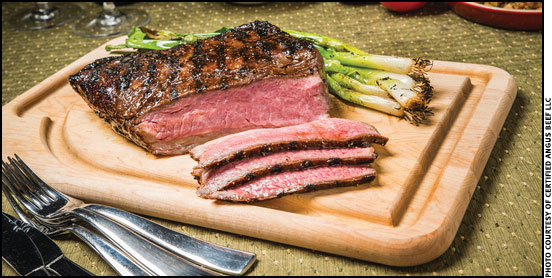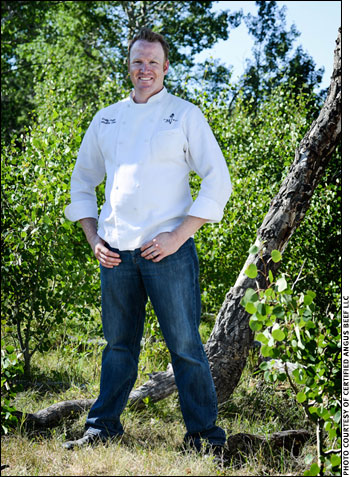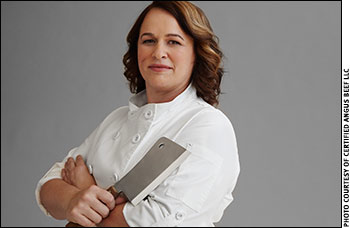
Price and Preference
Interactive consumer education drives beef demand.
Our eating habits used to be determined by the environment. People ate what they could get when they could get it. Today food is abundant in America, and eating habits are mostly by preference and price. With sustained higher costs, it’s price that influences more and more beef-buying decisions.
Craig Deihl, executive chef of Cypress in Charleston, S.C., says the higher price of beef chuck that many quick-service restaurants prefer for grinding could mean more expensive hamburgers. That leads some consumers to switch from beef to a cheaper option. However, Deihl says people going out for a nice steak dinner seem prepared to drop the extra cash for the experience they want.
Burger joints aside, the changes in beef-buying habits have affected retailers more than restaurants.

Craig Deihl, executive chef of Cypress in Charleston, S.C., says the higher price of beef chuck that many quick-service restaurants prefer for grinding could mean more expensive hamburgers. That leads some consumers to switch from beef to a cheaper option. However, Deihl says people going out for a nice steak dinner seem prepared to drop the extra cash for the experience they want.
Master butcher and founder of the Muscolo Meat Academy, Kari Underly says beef purchases in the home have also been affected, because many people are changing the way they view protein as a part of a meal.
“I think we’re just moving away from meat being the big, center of the plate that you build your meal around to using beef as more of an ingredient,” she says.
Beef products need to be more compatible with that mind-set, she says, suggesting less focus on large value packs alone and more development of products for one-pot meals, such as shreds for soups and strips for stir-fry.
“These items work because the package tells consumers exactly what to do with it,” Underly says, and that makes the meatcase less complicated.
Very few people want to spend money on a product they know nothing about, so restaurants can serve as a place for individuals to familiarize themselves with different cuts and methods of preparation.
The main beef focus revolves around middle meats like tenderloin and ribeye, but new cuts are gaining ground. Deihl sees a need for a wider range of education, and chefs have a role in that process. For instance, he frequently uses slow-cooking methods to prepare various cuts of beef and shares cooking tips.
“It’s a great option,” he says, and consumers need to know they can do the same thing. “You can buy this product, put it in your Crock-Pot® before you go to work, and when you get home it’s done.”
At Cypress they also seek to maximize the use and value of a whole beef carcass rather than picking and choosing a few specific cuts, Deihl says. That means offering a variety of beef products that may not be readily available in other dining establishments, such as the Denver cut, culotte and the sirloin flap.
“If you’re looking for something unique and different and super tasty, try one of those cuts,” Deihl says. Not only do they have a rich, beefy flavor, but they are at a better price point than the most popular steaks like tenderloin and ribeye.
Education key
Again, the key is education. Even if consumers see a newer, cheaper cut at the meat counter — or a familiar cut prepared a different way, such as strips or shreds — they still may not buy it. People like to buy the things they know and understand.

“Ask questions or tell your butcher what kind of dish you [are] wanting to make, and they can help you pick the right cut of beef,” Kari Underly urges. Beef is more expensive. To justify the cost, people need to have a great eating experience, and proper preparation ensures each cut of beef will taste its best.
Underly says more training is exactly what’s needed at the grocery store level, and it needs to be updated for today’s consumers and meat cuts.
“We try to provide tools to the retailers, but are they the right tools?” she asks. “The traditional model is develop a cut, develop a program, create point-of-sales materials, put them up in the meatcase, and see what happens.”
Rather than playing the wait-and-see game, Underly is working to help improve product knowledge and merchandising methods in grocery stores across the nation. By year’s end, retailers will be able to enroll in the online Meat Merchandiser Certification Program through Muscolo Meat Academy.
Retailers’ knowledge about their beef products has very little value if it is not shared. So consumers need to talk to the people behind the meat counter.
“Ask questions or tell your butcher what kind of dish you [are] wanting to make, and they can help you pick the right cut of beef,” Underly urges. Beef is more expensive. To justify the cost, people need to have a great eating experience, and proper preparation ensures each cut of beef will taste its best.
Certified Angus Beef® (CAB®) brand meat scientist Phil Bass agrees. That’s why well-trained staff members need to be on hand to engage consumers in conversation, acting as consultants.
“Some of our retail partners have moved to a more ‘restaurant-style’ steak in the meat case,” he says. A higher price per pound is offset by the smaller portion for a “gentler sticker price.” Other partners have redesigned their layout to create an “open meat counter for more interaction between staff and customers. Some are investing in apprentice meat cutters to create more experts in their stores.”
The idea is to help everyone from the casual shopper to those looking for a specific item. Some of the newer beef cuts have a variety of names, so communication is vital.
A butcher may even be able to cut a specific item for the consumer. For instance, Underly says most grocers have the sirloin and can easily separate the culotte. All consumers need to do is ask.
When costs increase, efficiency becomes more important. On the restaurant side, Deihl says chefs and restaurant managers can help themselves by using more of the beef carcass.
“We use our beef trims for grinding, frying or making stock, and we promote it as such,” he says. “Those are all added carcass utilizations, and eventually the economics of it work in your favor.”
The nutrition of beef has its own efficiency for consumers, as well.
Underly points out that even in small portions, beef is very nutrient-dense.
“When you’re trying to be efficient with your food sources, I think beef in a healthy portion is really the way to go. It’s Mother Nature’s multivitamin.”
And then there’s the taste that keeps plenty of people coming back for more no matter the cost. “The great thing about a nice piece of beef is it just stands on its own. It has good texture, and you don’t need to marinate it to give it flavor,” Underly says. “It’s just beefy and that’s what we love.”

Editor’s Note: Lyndee Stabel is a freelance writer for Certified Angus Beef LLC (CAB).





